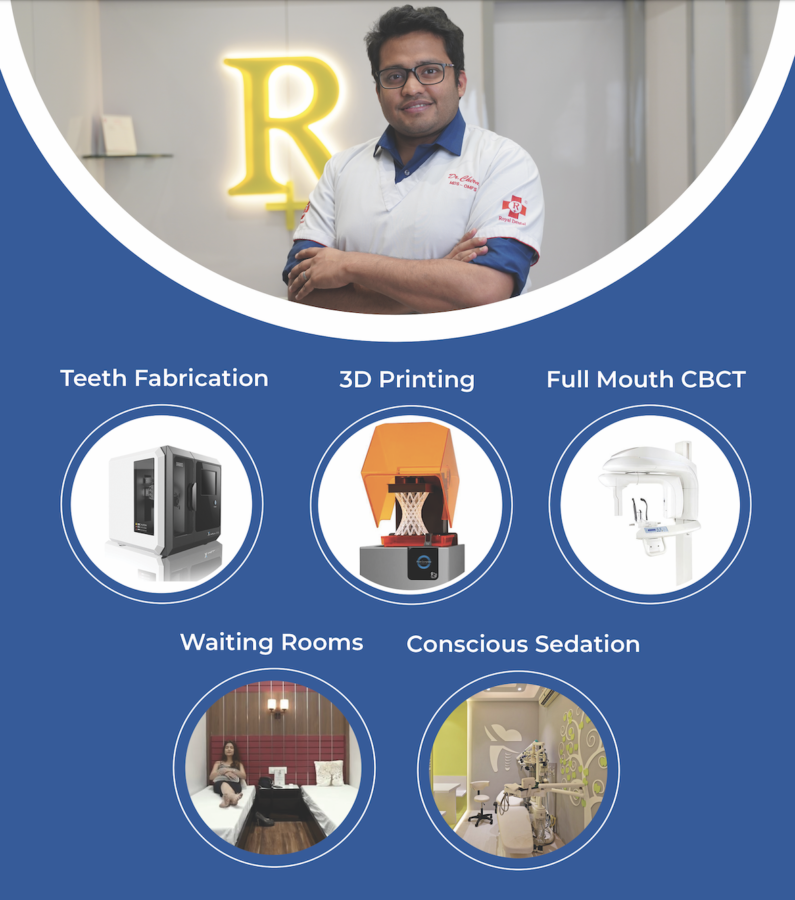In recent years, we have witnessed remarkable advancements in the field of artificial intelligence (AI). This cutting-edge technology has found its way into various industries, and dentistry is no exception. As an esteemed dentist at Royal Dental Clinics, I am excited to explore how AI is transforming the world of dentistry, revolutionising the way we diagnose and manage treatment. In this article, we will delve into the potential benefits and applications of AI in dentistry.
Diagnosis and Treatment Planning | Dentistry
AI might enhance dental diagnosis and treatment planning. It can help dentists improve diagnosis and treatment plans by analysing massive volumes of dental data and using machine learning algorithms. AI can spot early dental issues that humans may overlook. It’s algorithms may detect minor irregularities in dental imaging like X-rays and CT scans that suggest cavities, gum disease, or oral cancer. Early detection lets dentists treat patients faster and improve results.

It may also evaluate orthodontic-required dental problems. AI systems can anticipate treatment results by analyzing dental photos and patient data, helping dentists choose the best therapy. Orthodontics requires careful measurements and analysis. It can help with treatment planning and picture analysis. AI algorithms may help dentists create personalised treatment plans by analyzing patients’ dental records, medical histories, and other data. This may include suggestions for the patient’s best treatments.
AI (Artificial Intelligence) is increasingly being integrated into advanced dentistry treatments, revolutionising the field and improving patient care.
- Diagnosis and Imaging: AI algorithms can analyse dental images, such as X-rays, CT scans, and intraoral photographs, to assist dentists in detecting and diagnosing various dental conditions.
- Treatment Planning: AI can aid in treatment planning by analysing patient data, such as dental records, medical history, and imaging results, to generate personalised treatment plans.
- Virtual Simulations and 3D Printing: AI-powered software can simulate virtual treatment outcomes, allowing dentists to visualise the potential results before initiating procedures.
- Robotics-Assisted Dentistry: AI can be integrated with robotic systems to assist dentists during complex procedures, such as dental implant placement and oral surgeries.
- Patient Engagement and Education: AI-powered applications and virtual reality (VR) platforms can be used to educate and engage patients in their dental care.
Enhanced Dental Imaging and Analysis
AI has the potential to significantly enhance dental imaging techniques and analysis, revolutionizing the way dentists diagnose and monitor oral health conditions. By leveraging AI algorithms, dental professionals can achieve greater accuracy, efficiency, and depth of analysis in various imaging modalities.

One of the key advantages of AI in dental imaging is its ability to detect and analyze minute details and anomalies that may go unnoticed by human interpretation alone. AI algorithms can process digital images, such as X-rays, 3D scans, and intraoral images, to identify subtle changes, abnormalities, or patterns indicative of dental diseases or conditions. This capability allows for early detection and intervention, leading to improved treatment outcomes and patient care.
Intelligent Virtual Assistants in Dentistry
AI has the potential to significantly enhance dental imaging technique.This can revolutionise the way dentists diagnose and monitor oral health conditions. By leveraging AI algorithms, dental professionals can achieve greater accuracy, efficiency, and depth of analysis in various imaging modalities.
AI’s capacity to spot minute features and irregularities in dental imaging is a major benefit. X-rays, 3D scans, and intraoral pictures may be processed by AI algorithms to detect minor changes, anomalies, or patterns that indicate dental disorders or problems. This skill improves treatment results and patient care via early diagnosis and action.
AI may also help segment oral cavity structures. AI systems can properly define teeth, gums, bones, and other anatomical features for extensive examination. This segmentation helps identify problem areas including dental decay, bone loss, and gum disease for focused therapy.
Predictive Analytics and Preventive Care
Predictive analytics and AI enable dentists to identify individuals at a higher risk of developing oral health conditions. Dentists can create personalised preventive care plans based on an individual’s unique risk profile, offering targeted interventions to mitigate potential oral health issues. AI algorithms can recommend specific oral hygiene practices, dietary modifications, or lifestyle changes tailored to an individual’s risk profile.
Prompt intervention based on early detection can prevent the progression of dental conditions and lead to more successful treatment outcomes. Predictive analytics may help public health efforts by analyzing population-level data and detecting oral health risk and illness trends. This information can inform the development of targeted interventions and education programs. This helps to promote oral health awareness and improve overall oral health outcomes on a larger scale.
Robotic Dentistry Treatment
Robotic dentistry utilizes advanced robotic systems and AI algorithms to assist and enhance various dental procedures. AI algorithms enable robotic systems to adapt to each patient’s unique oral anatomy, ensuring precise and personalised treatment. Robotic systems can assist in a wide range of dental procedures, including dental implant placement, tooth extractions, and orthodontic adjustments.
Robotic dentistry improves the efficiency of dental procedures, reducing the time required for treatment and improving patient experience. These systems can be equipped with advanced imaging and sensing technologies, providing real-time feedback to dentists and enhancing the precision of procedures. The adoption of robotic dentistry requires appropriate training for dental professionals to effectively operate and utilize the robotic systems. Ethical considerations, patient comfort, and safety should always be prioritized when incorporating robotic systems into dental practice.
Data Security and Privacy
Data security and privacy are critical aspects of integrating AI into dentistry. It’s crucial to secure patient privacy and data security as healthcare data becomes digital and AI algorithms handle sensitive information.
Dentists must implement stringent cybersecurity measures to safeguard patient data from unauthorized access, breaches, or cyberattacks. Robust encryption protocols should be in place to protect data both at rest and in transit.
Regular data backups and disaster recovery plans should be established to mitigate the risk of data loss or corruption. Patient consent should be obtained and documented for the collection, storage, and processing of their personal health information.
Regular audits and assessments should be conducted to identify and address potential vulnerabilities in AI systems and data storage infrastructure. Dental staff should get data security and patient privacy training. Dental practices should have incident response plans in place to promptly address and mitigate any data breaches or
Conclusion
AI in dentistry has the potential to improve patient care, diagnosis, treatment planning, administrative activities, and preventative dentistry. As dentists at Royal Dental Clinics, we are excited about the possibilities AI offers to transform the oral healthcare landscape. However, it is crucial to strike a balance between embracing AI advancements and preserving the invaluable human touch that defines the dentist-patient relationship. By leveraging the power of AI while upholding ethical standards and providing personalized care, we can pave the way for a brighter future in dentistry.
© All rights reserved by Royal Dental Implants Pvt Ltd
Issued in public interest






